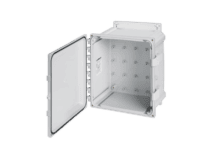The EC2B Series from IDEC Corporation is a line of enclosures, control stations, and accessories for hazardous location (HazLoc) applications. These products deliver value and time savings with global approvals for hazardous environments, popular standard control station configurations, and customized control station configurations built and delivered to user specifications.
 The EC2B Series standard and custom control stations utilize IDEC’s EU2B line of 30mm hazardous location pushbuttons, pilot lights, selector switches, key selector switches, emergency stop switches, and analog meters. The EU2B safety devices are fully sealed to prevent the release of enough electrical energy to ignite explosive gases or vapors into the environment.
The EC2B Series standard and custom control stations utilize IDEC’s EU2B line of 30mm hazardous location pushbuttons, pilot lights, selector switches, key selector switches, emergency stop switches, and analog meters. The EU2B safety devices are fully sealed to prevent the release of enough electrical energy to ignite explosive gases or vapors into the environment.
Users can choose either a standard or a custom EC2B control station. Standard control stations include the most popular and common options. If one of the standard control stations does not fit the application requirements, users can specify a custom control station by selecting from the wide variety of EU2B control devices and enclosures. IDEC will build the custom control station to user specifications, deliver the station with drawings, and provide a part number for future orders.
All EC2B and EU2B products are UL certified for use in Zone 1 and Zone 2, and are also certified for use in hazardous locations by IECEx (Global), ATEX (Europe), and TIIS (Japan). The enclosures and fully sealed pilot devices are rated IP65 and Type 4X for protection against water and corrosion, and are available with exposed or finger-safe IP20 screw terminals. The enclosures are constructed of 304 stainless steel to provide long service life in hazardous and corrosive areas.
Industries with hazardous areas include chemical, oil and gas, mining, water/wastewater, and power. These industries have a need for control stations and components which can be installed in hazardous areas—but want to avoid the complications, expense, and maintenance requirements of alternative protection methods such as purge systems and intrinsically safe designs.





















![[VIDEO] Collect Asset Data at the Speed of Walking a Building](https://facilityexecutive.com/wp-content/uploads/2024/02/maxresdefault-324x160.jpg)